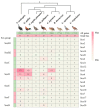Systematic Identification and Evolution Analysis of Sox Genes in Coturnix japonica Based on Comparative Genomics
- PMID: 31013663
- PMCID: PMC6523956
- DOI: 10.3390/genes10040314
Systematic Identification and Evolution Analysis of Sox Genes in Coturnix japonica Based on Comparative Genomics
Abstract
Coturnix japonica (Japanese quail) has been extensively used as a model animal for biological studies. The Sox gene family, which was systematically characterized by a high-mobility group (HMG-box) in many animal species, encodes transcription factors that play central roles during multiple developmental processes. However, genome-wide investigations on the Sox gene family in birds are scarce. In the current study, we first performed a genome-wide study to explore the Sox gene family in galliform birds. Based on available genomic sequences retrieved from the NCBI database, we focused on the global identification of the Sox gene family in C. japonica and other species in Galliformes, and the evolutionary relationships of Sox genes. In our result, a total of 35 Sox genes in seven groups were identified in the C. japonica genome. Our results also revealed that dispersed gene duplications contributed the most to the expansion of the Sox gene family in Galliform birds. Evolutionary analyses indicated that Sox genes are an ancient gene family, and strong purifying selections played key roles in the evolution of CjSox genes of C. japonica. More interestingly, we observed that most Sox genes exhibited highly embryo-specific expression in both gonads. Our findings provided new insights into the molecular function and phylogeny of Sox gene family in birds.
Keywords: HMG-box; Japanese quail; SOX; gene family; genomics.
Conflict of interest statement
The authors declare no conflict of interest. The funders had no role in the design of the study; in the collection, analyses, or interpretation of data; in the writing of the manuscript, or in the decision to publish the results.
Figures









Similar articles
-
Genome-wide identification, phylogeny and expressional profile of the Sox gene family in channel catfish (Ictalurus punctatus).Comp Biochem Physiol Part D Genomics Proteomics. 2018 Dec;28:17-26. doi: 10.1016/j.cbd.2018.03.001. Epub 2018 Mar 6. Comp Biochem Physiol Part D Genomics Proteomics. 2018. PMID: 29906772
-
Genome-Wide Identification and Transcriptome-Based Expression Profiling of the Sox Gene Family in the Nile Tilapia (Oreochromis niloticus).Int J Mol Sci. 2016 Feb 23;17(3):270. doi: 10.3390/ijms17030270. Int J Mol Sci. 2016. PMID: 26907269 Free PMC article.
-
Duplication and expression of Sox genes in spiders.BMC Evol Biol. 2018 Dec 27;18(1):205. doi: 10.1186/s12862-018-1337-4. BMC Evol Biol. 2018. PMID: 30587109 Free PMC article.
-
Phylogeny of the SOX family of developmental transcription factors based on sequence and structural indicators.Dev Biol. 2000 Nov 15;227(2):239-55. doi: 10.1006/dbio.2000.9883. Dev Biol. 2000. PMID: 11071752 Review.
-
Function and molecular evolution of mammalian Sox15, a singleton in the SoxG group of transcription factors.Int J Biochem Cell Biol. 2010 Mar;42(3):449-52. doi: 10.1016/j.biocel.2009.10.023. Epub 2009 Nov 10. Int J Biochem Cell Biol. 2010. PMID: 19909824 Review.
Cited by
-
Molecular Evolution and Inheritance Pattern of Sox Gene Family among Bovidae.Genes (Basel). 2022 Oct 2;13(10):1783. doi: 10.3390/genes13101783. Genes (Basel). 2022. PMID: 36292668 Free PMC article.
-
The magnetic beads-based sandwich-shaped immune complexes for rapid and sensitive amperometric detection of SOX2 protein.Turk J Chem. 2024 Dec 16;49(1):79-88. doi: 10.55730/1300-0527.3712. eCollection 2025. Turk J Chem. 2024. PMID: 40104101 Free PMC article.
-
Annexin A's Life in Pan-Cancer: Especially in Glioma Immune Cells.Neuromolecular Med. 2025 Feb 26;27(1):17. doi: 10.1007/s12017-024-08827-9. Neuromolecular Med. 2025. PMID: 40011350 Review.
-
Glutathiones' life in multi-cancers: especially their potential micropetides in liver hepatocellular carcinoma.Discov Oncol. 2025 Feb 18;16(1):201. doi: 10.1007/s12672-025-01945-1. Discov Oncol. 2025. PMID: 39966283 Free PMC article.
-
The De Novo Genome Sequencing of Silver Pheasant (Lophura nycthemera).Genome Biol Evol. 2021 Dec 1;13(12):evab275. doi: 10.1093/gbe/evab275. Genome Biol Evol. 2021. PMID: 34904656 Free PMC article.
References
Publication types
MeSH terms
Substances
LinkOut - more resources
Full Text Sources
Miscellaneous

